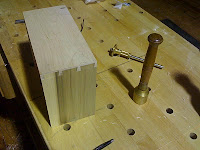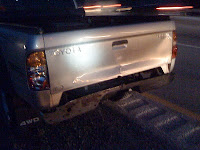Edit: 12/19/2011: I have written up a more concise and better illustrated narrative on how to install the Emmert Pattern Maker's vise
here.
Edit: 11/1/10: The bench is back together, and I've since posted
some tips for anyone who wants to install one of these monstrous miracles.
So, I've been playing with... er... USING... the Emmert for a few weeks now, and I've run into a problem. Setting the vise into the front edge of the bench top was simply not a good idea. At least, not the way I was trying to do it. I read
Roger Van Maren's account of how to do a flush mount, and it looked nice enough to me. And the lasting impression was that it would be a good idea.
Originally, I had a mental image of a big vise, traced out and neatly inset into the front of the bench. I thought that a reasonable clearance around the vise would be enough to let it rotate freely. It sounded neat, and clean. The reality is that the Emmert Universal vise is Big, Versatile, and it Needs Room to move around. My own mental image of an inset vise has proven to be possible, but impractical, as it restricts the most useful features of the vise.
I struggled with the issues of laying out and mounting the vise, and this is a brief run-down of my experiences in mounting an Emmert U-6 Universal. I'm not saying that this is the way to do it, I'm simply putting down what I went through to learn what I know now.
The U-6 is huge. The main jaws are 18" wide, and 6" high. This is without the small machining jaws that are on the bottom, which have already proven their worth. The whole thing weighs something in the neighborhood of 90 pounds. This is not like other vises I've installed. Most others I could mount by lying on the floor, holding up with one hand, and drilling and installing mounting bolts with the other. Installing an Emmert is a not so easy.
---------------------------------------------------------------------------------
I knew I wanted the rear jaw to be flush with the bench. But the fact still remained that I needed to figure out a practical way to do an accurate layout, so that I could mount 90 pounds of cast iron with half a hope of getting it where I wanted it.

Eventually I conceived of clamping a board to the front edge of the bench, and wrapping the vise around that. The back face of the board would align the vise with the front face of the bench. Brilliant! After this, I took the vise off, laid down a piece of plywood to trace out my pattern, and put the vise back in place. I used the old pencil and washer trick to trace around the vise, and made a pattern that I could use to cut out my inset. And it worked.
I think that laminating another piece to the front of the bench to be in line with the vise is a better idea than flush mounting. But for those of you who want to keep the front of the bench the way it is, and are cutting into an existing bench top, I think a square cut corner notch is the way to go. But you still need to lay out and align everything before you cut the notch out. And the method I just described proved to be a viable way to do that before you cut into anything.
-Side note on the mounting plate. I mounted the plate to be just below the bench surface, which makes sense to me. But it wasn't a simple routing job. The mounting plate is actually tapered in thickness, and is thicker down where the holes are for the screws. So I had to use a chisel to make the recess deeper at the other end. I had read somewhere that the vise requires #18 wood screws. So, that's what I bought. And when it came time to do the mounting, they turned out to be too big. I drilled out the holes and countersunk further. So, my vise uses #18, but my suspicion is that other vises may call for something smaller.

-Cutting everything out. Using the pattern I got from tracing out the upside-down vise, I used a router with bearing bits to cut into the bench top. But then I realized that I couldn't rotate the vise within the cutout. So, I broke out the carving tools and went to work. It was a pain in the ass.
AND I had to hog out a trench for the beam that houses the threaded rod. I've seen pictures of the chunk of wood that has to come out to clear the vise hub, but I hadn't really thought about beam clearance. Without the trench, the beam hit the underside of the bench, and the vise wouldn't sit square. Clearly, my bench top is thicker than the ones I've seen other pattern vises mounted to. Or, maybe I am. Or both.
-Recently, I noticed that when the vise is tilted, and I rotated the vise, the top flange of the rear jaw bangs into the top, front edge of the inset. I'd carved out a curved recess to allow the vise to rotate in a vertical direction, but it was looking like I'd have to carve more to allow it to rotate around the top edge of the inset. I decided that I'm not going to keep carving forever to make more and more clearances around the vise. It probably would have been an easy fix, but the process so far has just made things uglier and uglier.

-Flash forward to the other night. I had wrapped up work on another project, and the bench was cleaned off. I took advantage of the opportunity, and took the vise off. I took the bench top to the band saw, and ripped a notch where the vise is to be mounted. I made the crosscut to take the last piece out with a Festool track saw. If there's an irony here, it's that it was easier to move the whole 8' bench top to the band saw to do the ripping, but it was easier to do the crosscutting part with a handheld power tool.
As I said before, if I were going to build a bench to hold an Emmert, I'd laminate most of the top, mount the vise, and then laminate one more board to the front to get the front edge to be flush with the rear jaw. This whole learning process has done nothing but reinforce that opinion.
On the one hand, I hope it'll be the last time I have to deal with any of this, and I can now get back to work. On the other hand, knowing what I know now, it would also be fun, for the sake of the blog, and the people who read it, to do a new install, and document the process a little better. I'm on the fence about writing up my own version of a comprehensive set of mounting instructions; there are a lot of good resources out there already, and between this entry, and the second one, I think I've put up all the information that I would have found to be useful. But if I get enough requests for a step-by-step, comprehensive instruction set, I'll do it.
































